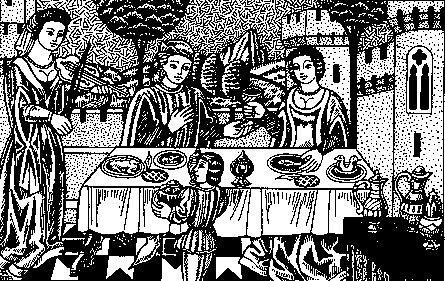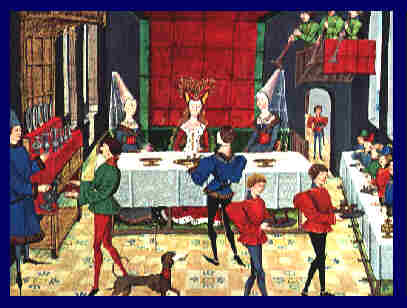Food in Medieval Jewish Spain
Updated May 25, 1999

The main meat in Sepharad, for Jews, Muslims, and Christians alike, is mutton. The land is excellent for raising sheep, not cattle. Of course, meat for Jews must be processed by Jewish butchers, to ensure that it is kosher. A discussion of the laws surrounding Jewish food in Spain is here (in Spanish). The baldios or “empty lands” of the center of the peninsula are the common graze lands for sheep (and also goats), both the moto bajo, the heathlands, and monto alto, the wastelands. The sierras and high plateaus of Castile are the summer pastures or agostaderos of the great sheep-owners. The popularity of sheep implies that at least some cheese of the period is made from ewe's milk, like the modern queso manchego (see below).
The Sephardic Cookbook (see Resources section) provides a list of kosher fish from Spain. While I do not know if they were in fact eaten in period, the book lists their names in Ladino, which at least might imply that they were known to Jews before the expulsion. They are: boqueron (anchovy), lubina (bass), bacalao (cod), merluza (hake), caballo (mackerel), sardinia (pilchard, sardines), salmon (salmon), lenguada (sole), trucha (trout) and atun (tuna).
Other meats include ducks, capons, pigeons, quails, hares, and oxtongues - stewed or marinated.
When the Muslims entered Spain, they brought with them sugar cane, rice, palm trees (possibly date palms, possibly the kind with edible "hearts"), mulberry trees, and citron fruits, such as lemons and oranges. Oranges "of marvelous flavour" were especially common, both in orchards and even within the courtyards of city houses. There were also almonds, figs, grapes, apples, pomegranates, artichokes, onions, and olives. The Arabs also brought advanced knowledge of agriculture, including the use of irrigation, waterwheels, aqueducts, fertilizers, and grafting. Cereals were cultivated with swing plows, pulled by donkeys or mules.
Wine is quite common, even among the less conservative Muslims (alcohol is forbidden by Islam). It is measured in arrobes (about a liter) and setiers (about a half-liter). Jewish poets, such as Samuel ibn Nagrela, even wrote of nights of drinking:
My friend, tell me
When shall I pour you my wine?
The cry of the cock woke me.
And sleep has deserted my eyes.
Come out and see the morning light
Like a scarlet thread in the East.
Make haste, give me a cup,
Before the dawn starts to rise.
from L. Weinberger, 1973, Jewish Prince in Moslem Spain: Selected Poems of Samuel ibn Nagrela, University Press, AlabamaTravellers from other European countries describe the flavorings of pimentos, garlic, or saffron, and complain that the food is spicier than in other countries. Meat pies (empanadillas) are mentioned. The main meal is eaten at noon, and a cold meal is eaten in the evening. Inns (ventas) don't sell food, so travellers must carry food, buy from local butchers or hunters, or pay their innkeeper to buy for them (the meal, the bed, and "candle and service" are paid for separately). There are bodegones, taverns with food, and bodegones de puntapie, tavern stalls or counters in market places. Village peasants eat rye bread, cheese, and onions. (see Defourneaux, 1966)
In general, modern cuisine in the Iberian peninsula is influenced by the flavors of the Middle East, such as honey and cumin. Besides meat, poultry, game, and fish entrees, there are a wealth of dishes featuring beans, rice, eggs, vegetables, and savory pies that make a meal. Tapas - small morsels or appetizers in great variety --play a role in meals throughout the day.
So far, I have not had a chance to really research actual Jewish recipes from Medieval Spain. Your comments are welcome. What I have collected here is some preliminary information on "traditional" cooking in Spain, especially in the Toledo/Castile region, and "traditional" Sephardic cooking. Unfortunately, even though someone in a modern cookbook might claim that a recipe is from before the expulsion (pre-1492), there isn't any way of knowing whether it is in fact a period Medieval recipe. But Chaiya might say, "En tiempo de hambrera no hay mal pan" (In times of hunger no bread tastes bad)!
Duke Cariadoc has collected a number of authentic medieval recipes from original sources, and redacted (translated) a number of them into modern recipes. A number of these are Andalusian Islamic dishes from the medieval period. This excellent collection can be found at the Miscellany website. An Islamic Dinner, from original sources, is included, along with a discussion (in persona) of the recipes of al-Andalus. While I do not know if Andalusian Jews ate this type of food, this certainly shows what their Muslim neighbors ate.
His Grace warns that it is wisest to use period food sources, and not wise to use modern dishes and try to find medieval evidence for them.
Some Sephardic recipes "from Spain" found in The Sephardic Cookbook include: "fritata de espinaca" (spinach casserole?), "taramasalata" (fish roe), "Iman bayeldi", "kibbeh", and "bimuelos de chanukkah" (Hanukkah fritters). See these recipes from www.sephardim.com as well.
Tthe website, All About Spain, regarding traditional foods of the Toledo region: "Traditional gastronomy is simple but tasteful, with stews, game, sausages and the famous Manchego cheese." This is a sharp, tasty cheese that I really liked when I visited. It's not as strong as some cheeses, certainly not overpowering, but it does have bite to it.
All About Spain continues: "Recipes are influenced by the region's long tradition of hunting and cattle-breeding, but show Moorish influences as well.
"Quails are some of the most extraordinary pleasures for delicate palates. They are usually served either stuffed, Perdiz Estofado, or together with a particular kind of beans, Perdiz con Pochas. Very typical are as well lamb, fried or boiled, Cordero Asado or Cuchifrito, and the potato-omelet Tortilla a la Magra.
"But there are two products in particular that have made Toledo's cuisine internationally famous: Queso Manchego, a very mature cheese often made of ewe's milk, and marzipan which is produced here in extraordinary quality and exported into many countries.
"The wines of the region, D.O.C. La Mancha or Mentrida, are of high reputation as well. "
The website A Chaucerian Feast has a nice description of gentile (non-Jewish) medieval feasting practices, at least those in England in Chaucer's time. Since cheeses are eaten throughout the meal (even with beef) and pork is also served, obviously not all of it applies to Jewish medieval feasting.
But remember, "No onde naces, sino onde comes" (not where you are born, but where you eat)!
Here is a list of recipes for so-called "Typical Spanish Dishes". Please note that I do not yet know how old or authentic these are.
References
Defourneaux, Marcelin. Daily Life in Spain In the Golden Age, Translated by Newton Branch. Stanford University Press, 1966.
The Sephardic Cookbook...
See the book, "The Sephardic Kitchen," in the Resources section.
Weinberger, L. Jewish Prince in Moslem Spain: Selected Poems of Samuel ibn Nagrela, University Press, Alabama, 1973.

This page is part of Chaiya's Sephardic World, a website devoted to the history and culture of Jews in Medieval Spain. The site is centered around the fictional SCA persona of Chaiya bat Avraham Toledano, created by Stacy Braslau-Schneck, the author of these pages. Chaiya is a Jewish lady living in Toledo in the 1230s. The SCA, or Society for Creative Anachronism, is an educational organization devoted to researching and recreating the Middle Ages.
This page is part of Chaiya's Sephardic World, a website devoted to the history and culture of Jews in Medieval Spain. The site is centered around the fictional SCA persona of Chaiya bat Avraham Toledano, created by Stacy Braslau-Schneck, the author of these pages. Chaiya is a Jewish lady living in Toledo in the 1230s. The SCA, or Society for Creative Anachronism
, is an educational organization devoted to researching and recreating the Middle Ages.
I do not claim to be an historian, only a hobbyist. All errors are mine, all text is copyrighted to me, and all comments
are welcome! "Yad/Return" image ©2001 Ilene Winn-Lederer
Return to Chaiya's Sephardic World
Go on to Music page.
This page hosted by
Get your own Free Home Page